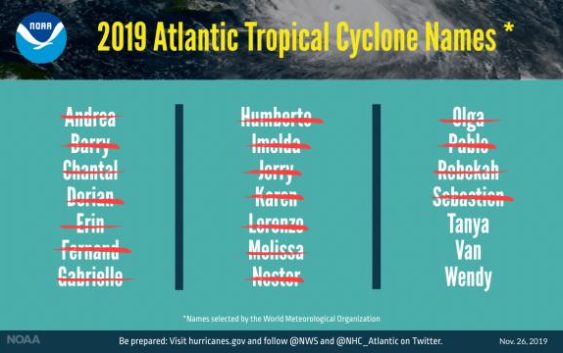- NC Gov. Stein pledges continued Hurricane Helene recovery support in 100-day address
- Austin adopts new map that greatly expands area at risk of wildfire
- CenterPoint Energy accelerates infrastructure improvements ahead of hurricane season
- Carolina Hurricanes playoff tickets go on sale Thursday
- Ask the Meteorologist: Why do tornadoes target Tornado Alley, Dixie Alley?
Above normal 2019 hurricane season officially over

Raleigh, N.C. — Hurricane season for 2019 is officially over and North Carolina — for the most part — was spared from widespread damage this time.
The Atlantic hurricane season ended on Nov. 30, spawning 18 named storms and included six hurricanes of which three were “major,” according to a statement on the website of the National Oceanic and Atmospheric Administration.
NOAA forecasters predicted at the start of the season that there would be 10-17 named storms, 5-9 hurricanes and 2-4 major hurricanes.
“During each and every hurricane season, thousands of workers across the federal government coordinate with NOAA to safeguard Americans against the threat posed by hurricanes,” said U.S. Secretary of Commerce Wilbur Ross in a written statement on NOAA’s site.
The agency said 2019 marks the fourth consecutive above-normal Atlantic hurricane season.
According to NOAA, the three major hurricanes this season were Dorian, Humberto and Lorenzo.
Dorian has been linked to the deaths of at least three people in North Carolina, a far lower number than the year that preceded 2019.
Hurricane Dorian is tied with three other hurricanes — the 1935 Labor Day Hurricane, 1988’s Hurricane Gilbert and 2005’s Hurricane Wilma — as the second strongest hurricane on record in the Atlantic basin in terms of wind (185 mph), the federal agency said.
In all, four storms made landfall in the U.S. during the 2019 season: Barry, Dorian, Imelda and Nestor.
Hurricane Dorian came ashore across coastal North Carolina and was blamed for flooding and heavy damage to some parts of the barrier islands.

